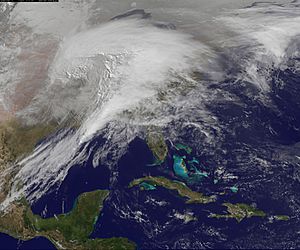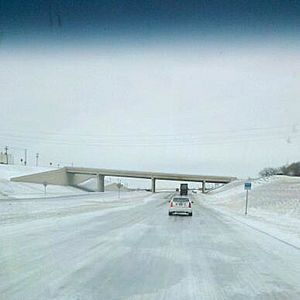January 31 – February 2, 2011 North American winter storm facts for kids
| Category 5 "Extreme" (RSI: 21.99) | |

The extratropical cyclone responsible for the blizzard striking the Midwestern United States on the afternoon of February 1
|
|
| Type | Extratropical cyclone Blizzard Ice storm Winter storm Tornado outbreak |
|---|---|
| Formed | January 31, 2011 |
| Dissipated | February 2, 2011 |
| Lowest pressure | 996 mb (29.41 inHg) |
| Maximum snowfall or ice accretion | 27.0 in (69 cm) snowfall – reported in Antioch, Illinois 1.0 in (2.5 cm) ice accretion – reported in Cashtown, Pennsylvania |
| Damage | $1.8 billion (USD) |
| Total fatalities | at least 36 fatalities |
The Groundhog Day Blizzard of 2011 was a huge winter storm that hit parts of Canada, Mexico, and the United States. It happened between January 31 and February 2, 2011. People called it the "Groundhog Day Blizzard" because it was around Groundhog Day.
This powerful storm brought over 14 inches (36 cm) of snow to many cities. These included Oklahoma City, Chicago, and Boston. South of the blizzard, a severe ice storm covered areas from Dallas to Indianapolis and near New York City. Some places saw more than 1 inch of ice. At the same time, heavy rain fell from Little Rock to New York City. Texas and Alabama even had strong thunderstorms and tornadoes. An EF1 tornado touched down in Alabama.
Contents
How the Groundhog Day Blizzard Formed and Moved
The storm began with strong thunderstorms and tornadoes in Texas. As it grew, it changed into a mix of different types of bad weather. This included a blizzard, an ice storm, heavy rain, and severe weather.
On February 1, the blizzard stretched from Oklahoma City all the way to Chicago. It brought heavy snow and very strong winds. Overnight, the storm moved from Chicago towards Boston. The blizzard dropped more than 14 inches of snow in Oklahoma City, Chicago, and Boston. The ice storm created up to 1 inch of ice. By February 2, the storm had moved out over the ocean. This huge storm affected more than 10 U.S. states.
Impact of the 2011 Winter Storm Across States
The Groundhog Day Blizzard caused different kinds of problems in different places.
How Texas and Oklahoma Were Affected
Texas experienced severe weather from the storm. This included tornadoes, hail, and strong thunderstorms. Oklahoma was hit by a blizzard and an ice storm on February 1. The blizzard brought over 14 inches of snow to Tulsa and Oklahoma City. It also had very strong winds. The blizzard in Oklahoma ended by the night of February 1.
Snow and Ice in the Midwest
Kansas received over 14 inches of snow in Kansas City and Topeka. In Nebraska, Omaha also got more than 14 inches of snow. Areas like North Platte had less than 1 inch. West of the blizzard, temperatures became extremely cold.
Iowa saw more than 14 inches of snow in Des Moines. The blizzard also caused over 14 inches of snow in Chicago. The ice storm brought about half an inch of ice to the Southeast. There was also about half an inch of rain there.
Most of Indiana had an ice storm. The southeast part of Indiana had heavy rain, while the northwest had a blizzard. The blizzard dumped several inches of heavy snow on northwest Indiana. The ice storm left 1 inch of ice on Indianapolis.
Storm Effects in Ohio, Pennsylvania, and New York
Half of Ohio experienced an ice storm, and the other half had heavy rain. The ice storm caused 1 inch of ice in Cleveland. The heavy rain produced 1 inch of rain in Columbus.
Most of Pennsylvania saw heavy rain. Much of the northwest part had an ice storm. Only the very northwest part of the state experienced a blizzard. The heavy rain caused 1 inch of rain in Philadelphia and Harrisburg. The ice storm dropped 1 inch of ice north of Pittsburgh. Pittsburgh also had 1 inch of heavy rain. The blizzard brought several inches of heavy snow to the far northwest.
New York state saw heavy rain, an ice storm, and the blizzard. The heavy rain caused 1 inch of rain in New York City. The ice storm brought 1 inch of ice to Albany. Albany also had several inches of snow. The blizzard dumped over 14 inches of snow in Buffalo.
Images for kids
-
NOAA color-enhanced photograph of storm system on February 1, 2011.
-
View of the U.S. midsection at 1:26 CST on February 10, 2011.
-
Chicago's Lake Shore Drive, with abandoned, snowed-in cars and empty lanes.
-
A Winter service vehicle abandoned and stuck on Lake Shore Drive during the storm.
-
In Tulsa, the storm set an all-time snowfall record.
-
Washington, DC, February 2, 2011 -- FEMA Administrator Craig Fugate (center, back to camera) and senior officials discuss the response to the massive winter storm affecting a large part of the nation during a videoteleconference with regional and federal partners at FEMA's National Response Coordination Center.
-
Abandoned CTA bus on Lake Shore Drive
-
Fullerton Ave. and Clark St. blocked by the Chicago Police during the storm
-
Cars buried in the Bridgeport neighborhood on Chicago's South Side
-
Truck driving through a snowstorm on Main Street in Kansas City, Missouri













